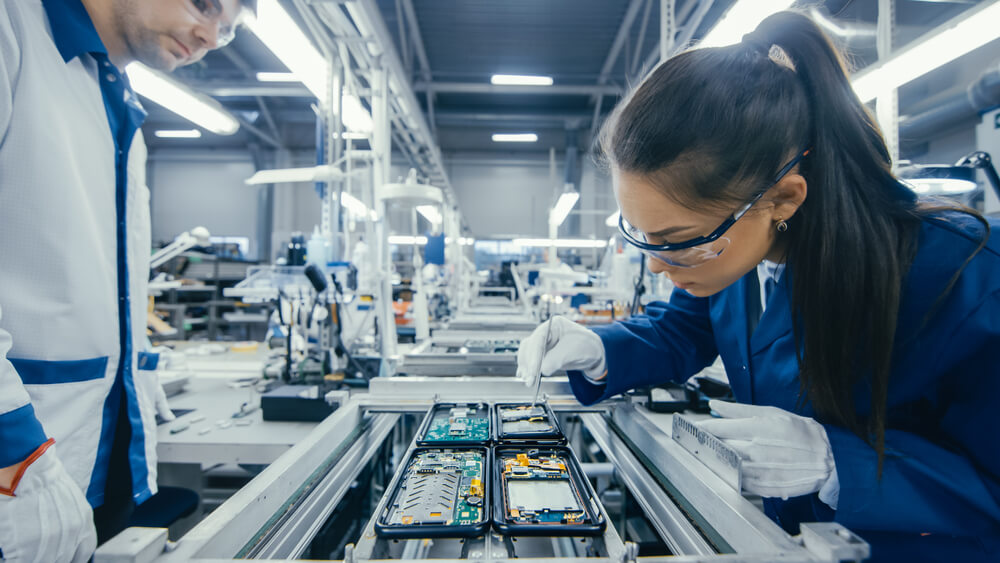Discrete manufacturing implies producing distinct items that require assembly along a production line, whereas process manufacturing produces goods in bulk, with the raw materials being mixed together in the manufacturing process. In this article, we will explore key differences between the two and look at examples of each.

- What is Discrete Manufacturing?
- What is Process Manufacturing?
- Discrete vs. Process Manufacturing in a nutshell
- Discrete vs. Process Manufacturing market requirements
- Key Takeaways
What is Discrete Manufacturing?
Discrete manufacturing is characterized by producing goods that are made up of many individual parts, the total number of which may often reach into the tens of thousands (cars, agricultural or military equipment, servers, etc.). This means that the process always involves assembly which is usually completed in many phases and often in different workstations. A smartphone, for example, is made up of a variety of individual components – the LCD screen, the motherboard, the camera, etc. – that are each put together separately to be eventually compiled into a single product in the final assembly phase.
To keep the often highly complex manufacturing process in check, discrete manufacturing relies on using Bills of Materials, or BOMs, which designate all the individual parts that the product consists of, sometimes including even the fixing attributes like nuts and bolts. Furthermore, the components and sub-assemblies that the end-products are made of often require prior assembly themselves. In these cases, multi-level BOMs (and if the product is configurable – Matrix BOMs) are used to keep track of the complexity, making powerful MRP/ERP software a must for these types of manufacturing processes.
Production of units in discrete manufacturing usually happens in many different workstations that can either work independently of one another or sequentially. This makes keeping track of the routing of manufacturing operations another crucial attribute of the discrete manufacturing process. Using the smartphone example again, while it is possible to assemble the LCD screen and the power supply system separately, installing them on the motherboard requires sequential routing. Here again, a capable MRP system is required to ensure that the creation and assembly of the product is completed in the correct order and that all of the parts are made to close tolerances so they fit together perfectly.
What is Process Manufacturing?
Process manufacturing involves mixing, boiling, blending, or otherwise joining the ingredients together in a “process” that outputs a certain volume of produce, instead of individual units. For the most part, therefore, process manufacturing occurs in bulk quantities. Whereas discrete manufacturing relies on BOMs, process manufacturing uses recipes or formulas to determine the constituents of the product. Here too it is crucial that the production planning system a company employs has the technical capacity to accommodate scalability, process inspections, process approach, etc. If the formula or a recipe of a product is scalable, which is mostly the case in process manufacturing, different size batches of a product can usually be created using the same formula.
For example, if a factory produces cupcakes, it makes sense to produce the frosting for a batch of similarly flavored ones all at once, rather than mix the ingredients together per cupcake. If the inventory only has enough ingredients for half a batch though, formulas can easily be scaled down to produce half the amount of topping, rather than halt production altogether. This is distinct from discrete manufacturing where it is not possible to create half a motherboard if only half of the required capacitors are in inventory.
Unlike in discrete manufacturing, the individual parts that make up the final product in process manufacturing are not easily identified after they have been processed. While items produced in discrete manufacturing are usually able to be disassembled back to their original components, products made by mixing components together are not. It is impossible to make shale oil back into coal or whipped cream back into milk, for example.
Discrete vs. Process Manufacturing in a nutshell
| Discrete manufactured items are notable for the following: |
| Standard parts and components |
| Distinct products, assembly reversible |
| Unit of measures: individual components |
| Bill of materials |
| Assembling and routing |
| Process manufactured items have different traits: |
| Variable ingredients |
| Batches of product, assembly irreversible |
| Unit of measure: weight of volume, batches |
| Recipes and formulas |
| Mixing and blending |
Discrete manufacturers create finished goods like automobiles and smartphones. These are made up of parts, assembled using screws and nuts or other fixtures, and can mostly be taken apart later on. Process manufacturers, on the other hand, produce goods that cannot be broken down into individual parts, e.g. paint or cupcakes. These types of goods are made from ingredients that are mixed together in a “process” that cannot be reversed. While discrete manufacturers use Bills of Materials to designate the contents of the products, process manufacturers rely on formulas or recipes.
Discrete vs. Process Manufacturing market requirements
It is important to note that while both process and discrete manufacturers can prefer either make to stock or make to order production strategies, the former is generally more common for process manufacturers, whereas the latter is more common in discrete manufacturing. The characteristics of the goods produced in process manufacturing and in bulk cannot generally be altered once production has started. On the other hand, discrete manufacturers tend to lean toward make-to-order (as well as engineer to order or configure to order) production strategies because the markets they are associated with favor customizability. This is especially the case for highly complex, engineered-to-order products where manufacturers need to have the flexibility to be able to continuously make adjustments in the work orders based on back-and-forth communication with the client, ensuring also that the product meets industry requirements and regulations.
Discrete manufacturing is mostly associated with vertical markets such as: machinery – appliances, machine tools, farm equipment, watches, etc.; electronics – computers, televisions, smartphones, tablets, etc.; defense and aerospace – fighter jets, tanks, submarines, drones, etc.; high-tech – industrial robots, industrial telecommunication arrays, etc.; automotive and transportation – cars, trucks, buses, vessels, etc.
Process manufacturing companies are most common in the following markets: foods and beverages, food processing, paints and coatings, tires, steel, aluminum and other metal fabrication, semiconductor fabrication, cosmetics and pharmaceuticals, textiles, plastics, petrochemicals, etc.
Key Takeaways
- Discrete manufacturing and process manufacturing describe the way in which goods are produced as well as the type of manufacturing process a company has set up.
- Discrete manufacturers produce individual items that consist of many different components and require assembly.
- Process manufacturers produce goods in bulk out of ingredients that require mixing, boiling, or otherwise joining them together in a (chemical) process.
- Discretely produced items are mostly able to be disassembled while processed goods are not.
- Discrete manufacturing uses Bills of Materials and routing to designate the contents and assembly sequence of produced items, while process manufacturing relies on formulas and recipes.

